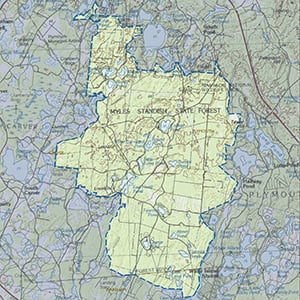Important Bird Area Sites in Massachusetts
Important Bird Area: Myles Standish State Forest
Site Summary
Nominated By
Glenn D'Entremont
Size
15,000 acres
Towns and Counties
Carver, Plymouth
Ownership
Department of Conservation and Recreation, private
Major Habitats
spruce-fir forest, oak-conifer forest, pitch pine-scrub oak
Land Use
nature & wildlife, conservation/ land trust, hunting and fishing, other recreation, forestry, undeveloped, water supply, utility right-of-way
Serious Threats
ecological succession, development, overuse
Minor Threats
cowbird parasitism, disturbance to birds and habitat
IBA Criteria
- Category 1: Sites important for long-term research and/or monitoring projects that contribute substantially to ornithology, bird conservation, and/or education.
- Category 4: Sites containing assemblages of species characteristic of a representative, rare, threatened, or unique habitat within the state or region.
- Category 5: Single-species Concentrations: The site regularly supports significant concentrations of a flocking species, but may not meet the thresholds above. The site should support a higher proportion of a species' statewide population (more than 1%, if known) than other similar sites.
Site Description
This site is an extensive pitch pine-scrub oak forest commonly referred to as pine barrens. There are several kettles-bodies of water with no inlet or outlet and little surface water because the sandy soil allows excellent drainage. This is a dry habitat on the surface; a water table is accessible to the shrubs and the larger pine trees, mostly White Pine. There are few waterways and bodies of fresh water without high tannic acid content.
Current Conservation Status
The site is a state forest, owned by the Commonwealth of Massachusetts.
Ornithological Significance
This area is a significant breeding site for the regional high conservation priority species (followed by numbers of breeding pairs and year of sample): Whip-poor-will, Brown Thrasher (11, 1996), Prairie Warbler (106, 1994), Eastern Towhee (152, 1994), and Field Sparrow (13, 1994). Estimates based on recent unpublished counts suggest at least 5 percent of the entire Massachusett population of Whip-poor-will exists within Myles Standish State Forest. During the 1960s a monograph was produced stating that the Miles Standish State Forest Prairie Warbler population was the densest in the world. Manomet Center for Conservation Sciences has been monitoring this site for over 30 years. Breeding bird surveys have been conducted for 24 years. At least 14 regional and five state conservation priority species breed within this site.
Other Flora or Fauna of Significance
Tiger beetles, moths, coastal plain pond vegetation (need more description), Plymouth Red-bellied Turtle
Data Sources
None provided




